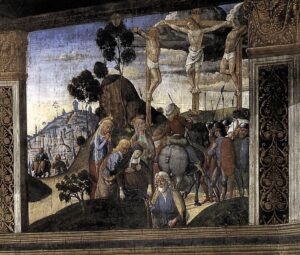Allegri, Miserere mei Deus

Gregorio Allegri (c. 1582-1652) composed his setting of Psalm 51 to be sung in the Sistine Chapel Tenebrae service on Holy Wednesday and Good Friday.
The work has been recorded frequently and is performed each year during Holy Week in many churches. But for many years it was not heard anywhere outside the Vatican. Its enormous popularity at services in the Sistine Chapel led the Vatican to prohibit performance in other venues. No one was allowed to copy or distribute the music on pain of excommunication. The mystique surrounding the work naturally grew.
In 1770, the 14-year-old Wolfgang Mozart was studying in Rome, and during Holy Week he attended the Holy Wednesday service in the Sistine Chapel. Afterwards he transcribed the piece from memory. He then returned on Good Friday to make a few minor corrections. Mozart’s father, Leopold, wrote to his wife from Rome in April 1770:
“…You have often heard of the famous Miserere in Rome, which is so greatly prized that the performers are forbidden on pain of excommunication to take away a single part of it, copy it or to give it to anyone. But we have it already. Wolfgang has written it down and we would have sent it to Salzburg in this letter, if it were not necessary for us to be there to perform it. But the manner of performance contributes more to its effect than the composition itself. Moreover, as it is one of the secrets of Rome, we do not wish to let it fall into other hands….”
Performances of the work in the Sistine Chapel included some additional improvised counterpoint, not written in Allegri’s score but handed down as part of the oral tradition. Those embellishments were apparently a significant factor in the work’s popularity.
The score was published in 1771 in England by music historian Charles Burney—without the improvisations. Burney had met with Mozart in Bologna soon after Mozart had made the transcription, and it is presumed that Burney obtained his copy from Mozart. But Mozart transcribed what he heard in the Sistine Chapel, and that presumably would have included the improvisations. So there is still some mystery surrounding the work and how Burney obtained a copy of Allegri’s score in its original form without the improvisations. (Mozart’s original transcription does not survive.) It is Burney’s published version that is commonly performed.



